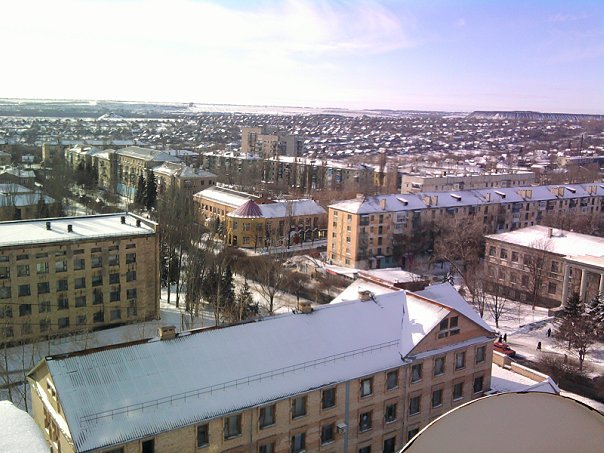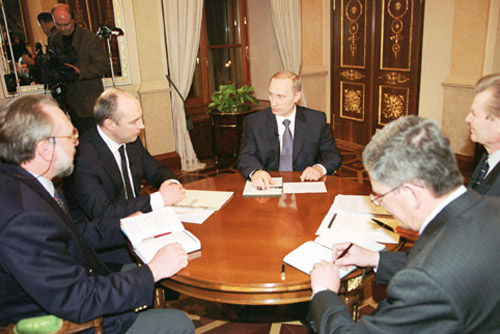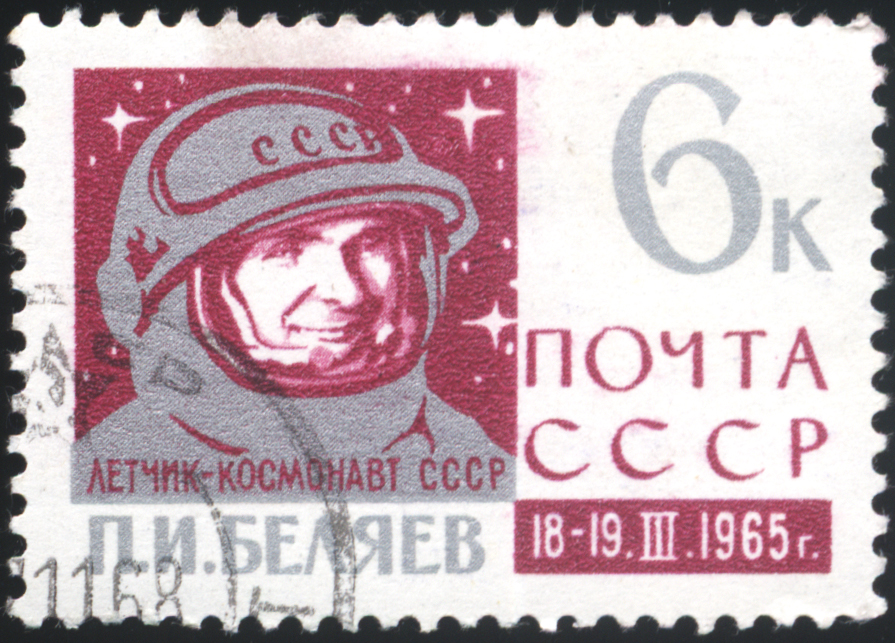|
Mikhail Beregovoy
Mikhail Timofeyevich Beregovoy (russian: Михаил Тимофеевич Береговой; 13 January 1918 – 30 May 2021) was a Soviet military officer who held a number of posts in the Soviet Air Defence Forces, reaching the rank of lieutenant general. Born in the upheaval of the October Revolution and the Russian Civil War, Beregovoy became interested in technical innovations. His brothers became pilots, his younger brother Georgy winning fame in the Second World War, and later as a pioneering cosmonaut, and twice Hero of the Soviet Union. Mikhail instead attended the and served as an officer with the Soviet Air Defence Forces. Following the war Beregovoy furthered his specialization with studies at the Artillery Radio Engineering Academy, and then joined the , in time becoming head of the radio engineering troops of the Moscow Air Defence District, with responsibility for monitoring and providing data for the flights of the early Soviet space program. In 1969 he became ... [...More Info...] [...Related Items...] OR: [Wikipedia] [Google] [Baidu] |
Torez
Chystiakove ( uk, Чистякове, ), formerly Torez ( uk, Торез), is a city of regional significance in the Donetsk Oblast in Ukraine. The city is a center of the regional coal industry and much of its economy relies on mining industries, despite a recent drop in the number of employed miners. The city has a population of Settled in 1778, the city was named Chystiakove in 1868. It was renamed Torez in 1964 for Maurice Thorez, a leader of the French Communist Party. In 2016, the Ukrainian parliament restored the historical name "Chystiakove" due to Ukrainian decommunization laws. Pro-Russian separatists took control of Chystiakove in June 2014.Letters From Donbas |
Hero Of The Soviet Union
The title Hero of the Soviet Union (russian: Герой Советского Союза, translit=Geroy Sovietskogo Soyuza) was the highest distinction in the Soviet Union, awarded together with the Order of Lenin personally or collectively for heroic feats in service to the Soviet state and society. Overview The award was established on 16 April 1934, by the Central Executive Committee of the Soviet Union. The first recipients of the title originally received only the Order of Lenin, the highest Soviet award, along with a certificate (грамота, ''gramota'') describing the heroic deed from the Presidium of the Supreme Soviet of the USSR. Because the Order of Lenin could be awarded for deeds not qualifying for the title of hero, and to distinguish heroes from other Order of Lenin holders, the Gold Star medal was introduced on 1 August 1939. Earlier heroes were retroactively eligible for these items. A hero could be awarded the title again for a subsequent heroic feat with ... [...More Info...] [...Related Items...] OR: [Wikipedia] [Google] [Baidu] |
Telemetry
Telemetry is the in situ data collection, collection of measurements or other data at remote points and their automatic data transmission, transmission to receiving equipment (telecommunication) for monitoring. The word is derived from the Greek language, Greek roots ''tele'', "remote", and ''metron'', "measure". Systems that need external instructions and data to operate require the counterpart of telemetry, telecommand. Although the term commonly refers to wireless data transfer mechanisms (e.g., using radio, ultrasonic, or Infrared#Communications, infrared systems), it also encompasses data transferred over other media such as a telephone or computer network, optical link or other wired communications like power line carriers. Many modern telemetry systems take advantage of the low cost and ubiquity of GSM networks by using SMS to receive and transmit telemetry data. A ''telemeter'' is a physical device used in telemetry. It consists of a sensor, a transmission path, and a ... [...More Info...] [...Related Items...] OR: [Wikipedia] [Google] [Baidu] |
Moskovskij Komsomolets
''Moskovskij Komsomolets'' (russian: Московский комсомолец, lit=Moscow Komsomolets) is a Moscow-based daily newspaper with a circulation approaching one million, covering general news. Founded in 1919, it is famed for its topical reporting on Russian politics and society. History The newspaper was first published by the Moscow Committee of the Komsomol on 11 December 1919 as ''Yuny Kommunar'' (russian: Юный коммунар, lit=Young Communard, links=no). Over the next years it changed its name several time, starting a few months after the first issue when it became the ''Yunosheskaya Pravda'' (russian: Юношеская правда, lit=Youth Truth, links=no). In 1924, after Vladimir Lenin's death, it was renamed to ''Molodoy Leninets'' (russian: Молодой ленинец, lit=Young Leninist, links=no). It took its present-day name in September 1929. Between 1931 and 1939, the paper ceased publication. It was revived in 1940, but not for long: Wo ... [...More Info...] [...Related Items...] OR: [Wikipedia] [Google] [Baidu] |
Alexei Leonov
Alexei Arkhipovich Leonov. (30 May 1934 – 11 October 2019) was a Soviet and Russian cosmonaut, Air Force major general, writer, and artist. On 18 March 1965, he became the first person to conduct a spacewalk, exiting the capsule during the Voskhod 2 mission for 12 minutes and 9 seconds. He was also selected to be the first Soviet person to land on the Moon although the project was cancelled. In July 1975, Leonov commanded the Soyuz capsule in the Apollo-Soyuz mission, which docked in space for two days with an American Apollo capsule. Early life and military service Leonov was born on 30 May 1934 in Listvyanka, West Siberian Krai, Russian SFSR. His grandfather had been forced to relocate to Siberia for his role in the 1905 Russian Revolution. Alexei was the eighth of nine surviving children born to Yevdokia and Arkhip. His father was an electrician and miner. In 1936, his father was arrested and declared an "enemy of the people". Leonov wrote in his autobiography ... [...More Info...] [...Related Items...] OR: [Wikipedia] [Google] [Baidu] |
Pavel Belyayev
Pavel Ivanovich Belyayev (russian: Павел Иванович Беляев; 26 June 1925 – 10 January 1970) was a Soviet fighter pilot with extensive experience in piloting different types of aircraft. He was the first commander of the cosmonaut corps and the cosmonaut who commanded the historic Voskhod 2 mission which saw the first man walk in space in 1965. Early life Pavel Belyayev was one of 6 children and was known as ''Pasha'' to his family and friends. He was born on 26 June 1925, in Chelishchevo, now Babushkinsky District, Vologda Oblast, Russia. In 1932 his family moved to the nearby village of Minkovo. His father was a physician's assistant and his mother worked on a collective farm. Belyayev began his schooling at the age of 7 in 1932. Physics and geography were his favourite subjects.Burgess and Hall, p.33 As a boy he enjoyed playing hockey and hunting. Just before his 13th birthday the family moved to Kamensk-Uralsky region. He continued his education at the Gorko ... [...More Info...] [...Related Items...] OR: [Wikipedia] [Google] [Baidu] |
Voskhod 2
Voskhod 2 (russian: Восход-2, , ''Sunrise-2'') was a Soviet crewed space mission in March 1965. The Vostok-based Voskhod 3KD spacecraft with two crew members on board, Pavel Belyayev and Alexei Leonov, was equipped with an inflatable airlock. It established another milestone in space exploration when Alexei Leonov became the first person to leave the spacecraft in a specialized spacesuit to conduct a 12-minute spacewalk. Crew Backup crew Reserve crew Mission parameters * Mass: * Apogee: * Perigee: * Inclination: 64.8° * Period: 90.9 min Space walk * Leonov – EVA – 18 March 1965 ** 08:28:13 GMT: The Voskhod 2 airlock is depressurized by Leonov. ** 08:32:54 GMT: Leonov opens the Voskhod 2 airlock hatch. ** 08:34:51 GMT: EVA start – Leonov leaves airlock. ** 08:47:00 GMT: EVA end – Leonov reenters airlock. ** 08:48:40 GMT: Hatch on the airlock is closed and secured by Leonov. ** 08:51:54 GMT: Leonov begins to repressurize the airlock. ** Duration: 12 ... [...More Info...] [...Related Items...] OR: [Wikipedia] [Google] [Baidu] |
Operation Barbarossa
Operation Barbarossa (german: link=no, Unternehmen Barbarossa; ) was the invasion of the Soviet Union by Nazi Germany and many of its Axis allies, starting on Sunday, 22 June 1941, during the Second World War. The operation, code-named after Frederick Barbarossa ("red beard"), a 12th-century Holy Roman emperor and German king, put into action Nazi Germany's ideological goal of conquering the western Soviet Union to repopulate it with Germans. The German aimed to use some of the conquered people as forced labour for the Axis war effort while acquiring the oil reserves of the Caucasus as well as the agricultural resources of various Soviet territories. Their ultimate goal was to create more (living space) for Germany, and the eventual extermination of the indigenous Slavic peoples by mass deportation to Siberia, Germanisation, enslavement, and genocide. In the two years leading up to the invasion, Nazi Germany and the Soviet Union signed political and economic pacts for st ... [...More Info...] [...Related Items...] OR: [Wikipedia] [Google] [Baidu] |
Winter War
The Winter War,, sv, Vinterkriget, rus, Зи́мняя война́, r=Zimnyaya voyna. The names Soviet–Finnish War 1939–1940 (russian: link=no, Сове́тско-финская война́ 1939–1940) and Soviet–Finland War 1939–1940 (russian: link=no, Сове́тско-финляндская война́ 1939–1940) are often used in Russian historiographybr>В.Н. Барышников. От прохладного мира к Зимней войне. Восточная политика Финляндии в 1930–е годы. Санкт-Петербург, 1997.; О.Д. Дудорова. Неизвестные страницы Зимней войны. In: Военно-исторический журнал. 1991. №9.; Зимняя война 1939–1940. Книга первая. Политическая история. М., 1998. – ; ttp://www.otvaga2004.narod.ru/photo/winterwar/wwar1.htm М. Коломиец. Танки в Зимней войне 19 ... [...More Info...] [...Related Items...] OR: [Wikipedia] [Google] [Baidu] |
Rehabilitation (Soviet)
Rehabilitation (russian: реабилитация, transliterated in English as ''reabilitatsiya'' or academically rendered as ''reabilitacija'') was a term used in the context of the former Soviet Union and the post-Soviet states. Beginning after the death of Stalin in 1953, the government undertook the political and social restoration, or political rehabilitation, of persons who had been repressed and criminally prosecuted without due basis. It restored the person to the state of acquittal. In many cases, rehabilitation was posthumous, as thousands of victims had been executed or died in labor camps. The government also rehabilitated several minority populations which it had relocated under Stalin, and allowed them to return to their former territories and in some cases restored their autonomy in those regions. Post-Stalinism epoch The government started mass amnesty of the victims of Soviet repressions after the death of Joseph Stalin. In 1953, this did not entail any form ... [...More Info...] [...Related Items...] OR: [Wikipedia] [Google] [Baidu] |
Great Purge
The Great Purge or the Great Terror (russian: Большой террор), also known as the Year of '37 (russian: 37-й год, translit=Tridtsat sedmoi god, label=none) and the Yezhovshchina ('period of Nikolay Yezhov, Yezhov'), was General Secretary of the Communist Party of the Soviet Union, Soviet General Secretary Joseph Stalin's campaign to solidify his power over the party and the state; the Purge, purges were also designed to remove the remaining influence of Leon Trotsky as well as other prominent political rivals within the party. It occurred from August 1936 to March 1938. Following the Death and state funeral of Vladimir Lenin, death of Vladimir Lenin in 1924 a power vacuum opened in the Communist Party of the Soviet Union, Communist Party. Various established figures in Lenin's government attempted to succeed him. Joseph Stalin, the party's General Secretary, outmaneuvered political opponents and ultimately gained control of the Communist Party by 1928. Initially ... [...More Info...] [...Related Items...] OR: [Wikipedia] [Google] [Baidu] |
Yenakiieve
Yenakiieve ( uk, Єна́кієве, ''Yenákiieve'', ; russian: Ена́киево, ''Yenákiyevo'') is a city in the Donetsk Oblast (province) of eastern Ukraine. It is incorporated as a city of oblast significance (a special status within the region equal to that of a raion (district)). The city stands on the Krynka River about from the oblast's administrative center, Donetsk. Its population is approximately . Yenakiieve is an important regional centre of coal mining, metallurgy, chemical production and manufacturing. The city's outdated industry has caused accidents like that of a gas explosion which occurred in June 2008 at one of Yenakiieve's coal mines. Yenakiieve was founded in 1898 when numerous workers' settlements around the Peter's Iron and Steel Works were united into a single settlement named after . Its first coal mines dated from 1883. The settlement was incorporated as a city in 1925. By 1958, the city and factories had expanded significantly and overtook the ... [...More Info...] [...Related Items...] OR: [Wikipedia] [Google] [Baidu] |






.jpg)

.jpg)
